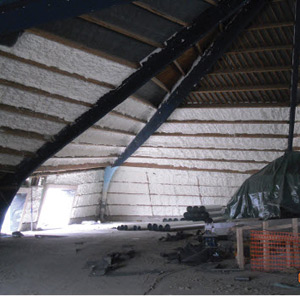Open Cell Spray Foam Insulation in Commercial Buildings
Enhancing Building Durability with Open Cell Insulation
Durability of a construction assembly and a building relies on the integrity of materials remaining intact during the full service life of the building. The biggest common threat to that integrity is damage from moisture seeping into enclosed cavities and causing damage to materials or structural components of a system. According to ASHRAE, moisture damage contributes to 90 percent of all building and building material failures. Moisture issues in commercial buildings contribute to the corrosion of metal components (i.e. ducts, framing) and the general degradation of other building materials (gypsum sheathing, ceiling tiles, wood products, etc.). Unwanted moisture in building systems can also create the growth of mold and poor indoor air quality thus affecting the health of the occupants.
The predominant source of this unwanted damage causing moisture is from air leakage which carries that moisture with it through openings or irregularities into wall and roof assemblies. In this case, low-density open cell spray foam insulation can play multiple roles in preventing moisture laden air from penetrating into a building assembly. By creating an effective air seal to begin with, the potential for air leakage and moisture penetration is reduced notably. If any moisture does get through, the insulation itself helps to prevent it from condensing by keeping the moisture laden air from meeting cold exterior surfaces.
The open cell make-up of the insulation helps manage any bulk water present by allowing it to drain away and enhancing the ability of the assembly to dry out. In roof assemblies, this quality can make it easier to spot the source of leaks and thereby permit any roof repairs to be made more easily. Even after minor wetting, most low-density open cell spray foam products are not a food source for mold so they will not contribute to that problem or the associated indoor environmental quality issues associated with it. Overall, creating an air barrier with low-density open cell spray foam insulation can pay off with a longer life of commercial building assemblies, can help prevent the need for costly repairs and can avoid lost operational time.
Separate from air leakage, the other means for vapor to enter an assembly is direct diffusion through materials. This raises the question of whether or not a vapor retarder is needed to stop that diffusion when open cell spray foam insulation is used. In the warmer U.S. climate zones 1 through 4, an interior vapor retarder is not required by code, with the exception of places where high interior relative humidity is present such as indoor swimming pools. In other climate zones or locations where a separate vapor retarder is required, it can often be achieved by using vapor retarder paint which creates a full and continuous barrier to moisture diffusion. Some approved vapor retarders can be painted directly onto the insulation in cases where the insulation is either exposed or the finished covering is not going to be painted. The more common approach is to use any one of a wide range of vapor retarder coatings available for painting on the sheathing or gypsum board which the open cell insulation is covered with. This vapor retardant paint then keeps any moisture from penetrating into the gypsum board or into the rest of the assembly.
Properly designed and installed then, roof and wall assemblies in commercial buildings that use open cell spray foam insulation and appropriate vapor retarders will notably reduce the chance of moisture damage and contribute to the overall durability and long term integrity of the building.











